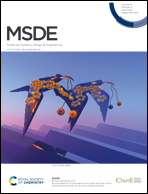Substituent effect on controlled release of fragrant aldehydes from pH-triggered nicotinoylhydrazone-based precursors†
Abstract
Fragrance precursors are an assorted class of pro-fragrances that could realize the controlled release of aromatic compounds. Herein, nicotinoylhydrazone-based pH-triggered fragrance precursors (NTA1–NTA4) have been prepared by reacting nicotinoylhydrazine with a series of aromatic benzaldehydes bearing different electron-donating groups. The chemical structures and substituent effects have been confirmed by FT-IR, NMR, mass and ultraviolet-visible (UV-vis) spectroscopies. Controlled release studies in an acidic environment revealed that a strong electron-donating substituent accelerates the release rate, while weak electron donor groups favor the deceleration of fragrance release. Surprisingly, intramolecular hydrogen bond formation (–OH⋯N![[double bond, length as m-dash]](https://www.rsc.org/images/entities/char_e001.gif) C–) has a positive impact upon the stability of the hydrazone bridge in precursor NTA4, consistent with the simulation of the molecular electrostatic potential (MEP) results. In addition, the release kinetics were also investigated and the release rate constant could be estimated with a first-order kinetic model (R2 > 0.98). Furthermore, it was demonstrated that fragrance precursors on cotton fabrics could be an efficient controlled release strategy for fragrant aldehydes after exposure to an ambient atmosphere for several days, compared to a reference sample containing the raw aroma chemicals.
C–) has a positive impact upon the stability of the hydrazone bridge in precursor NTA4, consistent with the simulation of the molecular electrostatic potential (MEP) results. In addition, the release kinetics were also investigated and the release rate constant could be estimated with a first-order kinetic model (R2 > 0.98). Furthermore, it was demonstrated that fragrance precursors on cotton fabrics could be an efficient controlled release strategy for fragrant aldehydes after exposure to an ambient atmosphere for several days, compared to a reference sample containing the raw aroma chemicals.



 Please wait while we load your content...
Please wait while we load your content...